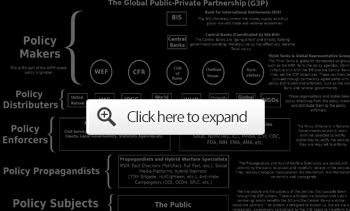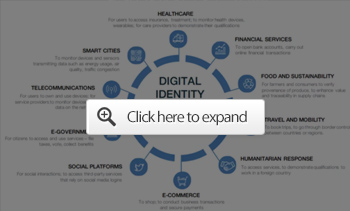by Dr. Joseph Mercola, Mercola:

STORY AT-A-GLANCE
- The United Nation’s Sustainable Development Goals are not about sustainability. They’re tools to facilitate the implementation of a One World Government
- The term the globalist alliance uses to describe its network is a “global public-private partnership,” or G3P. The G3P is composed of most of the world’s governments, intergovernmental organizations, global corporations, major philanthropic foundations, nongovernmental organizations (NGOs) and civil society groups. Collectively, they are the “stakeholders” that are implementing the SDGs
TRUTH LIVES on at https://sgtreport.tv/
- While SDG16 claims to advance “peaceful and inclusive societies” and “justice for all,” this goal is really about consolidating authority, exploiting threats to advance regime hegemony, and implementing a centrally controlled global system of digital identity (digital ID)
- A digital identity is not merely a form of identification. Your “identity” is who you are, and a digital identity will keep a permanent record of your choices and behaviors, 24/7. Universal adoption of digital identity will enable the G3P global governance regime to establish a behavioral-based system of reward and punishment
- The COVID pandemic was used to redefine human rights and to get people used to the idea that the rights of individuals are conditional and can be ignored or suspended “for the greater good.” The United Nations’ Charter establishes a global governance regime that stands against freedom, justice and peace, and all of the UN’s SDGs need to be understood within this context
At this point in time, it’s crucial to realize that the United Nations’ Sustainable Development Goals (SDGs) are part of the plan to implement a One World Government, where the entire world will be run by unelected bureaucrats beholden to technocratic ideals.
In a two-part Unlimited Hangout investigative series,1,2 independent journalists Iain Davis and Whitney Webb expose how Sustainable Development Goal No. 16 (SDG16), which claims to advance “peaceful and inclusive societies” and “justice for all,” is really about consolidating authority, exploiting threats to advance regime hegemony, and forcing a “centrally controlled global system of digital identity3 (digital ID) upon humanity.”
As explained in Part 1,4 the term the globalist alliance of technocrats use to describe its network is a “global public-private partnership,” or G3P:
“The G3P is toiling tirelessly to create the conditions necessary to justify the imposition of both global governance ‘with teeth’ and its prerequisite digital ID system. In doing so, the G3P is inverting the nature of our rights. It manufactures and exploits crises in order to claim legitimacy for its offered ‘solutions.’
The G3P comprises virtually all of the world’s intergovernmental organizations, governments, global corporations, major philanthropic foundations, non-governmental organizations (NGOs) and civil society groups. Collectively, these form the ‘stakeholders’ implementing sustainable development, including SDG16.”
The following chart, sourced from IanDavis.com,5 illustrates how the G3P operates.

What SDG16 Is Really About
The central objective of SDG16 is to strengthen the UN-led regime, and of all the subgoals included in this SDG, the establishment of “a legal identity for all” (SDG16.9), is the most crucial, as other goals rely on the use of digital identity. As noted by Davis and Webb:6
“Universal adoption of SDG16.9 digital ID will enable the G3P global governance regime’s to establish a worldwide system of reward and punishment. If we accept the planned model of digital ID, it will ultimately enslave us in the name of sustainable development …
SDG16.9 ‘sustainable development’ means we must use digital ID … Otherwise we will not be protected in law, service access will be denied, our right to transact in the modern economy will be removed, we will be barred from participating as ‘citizens’ and excluded from so-called ‘democracy.’”
Understanding Digital Identity
The World Economic Forum (WEF), founded by Schwab, has for years promoted the implementation of digital identity. The problem with calling it “digital ID” is that people misunderstand it to be something it’s not. There’s a huge difference between identity and identification.7
Identification refers to documents that prove you are who you say you are. A digital identity is NOT merely a form of identification. Your “identity” is who you actually are, and a digital identity will keep a permanent record of your choices and behaviors, 24/7.
Your identity encompasses everything that makes you unique, and that’s what the globalist cabal is really after. Step out of line, and every social media interaction, every penny spent and every move you’ve ever made can be used against you.
Indeed, having access to everyone’s digital identity is the key to successful manipulation and control of the global population. The graphic below, from the WEF, illustrates their idea of how your digital identity will interact with the world.
Everything you can think of is to be connected to your digital identity, and your behavior, beliefs and opinions will dictate what you can and cannot do within society. It will unlock doors where someone like you is welcome, and lock the ones where you’re not.
If you think the idea of vaccine passports is insane, wait until your access to critical infrastructure and services is dependent not just on your vaccination status, but also what books you’ve bought, what ideas you’ve shared, and who you’ve given money or emotional support to.

Interoperability Will Link Disparate Systems Together
As people are coming to understand the threat of a One World Government, resistance against digital ID and the social credit score that comes with it has started to mount. The G3P’s answer to that dilemma is the construction of an interoperable system that can link disparate digital ID systems together. As explained by Davis and Webb:8
“This ‘modular platform’ approach is designed to avoid the political problems that the official issuance of a national digital ID card would otherwise elicit.
Establishing SDG16.9 global digital ID is crucial for 8 of the 17 UN SDGs. It is the linchpin at the center of a global digital panopticon that is being devised under the auspices of the UN’s global public-private partnership ‘regime.’”
You Have No Rights, Only Permits, Under the New World Order
You may be wondering where human rights enter into all of this. If your digital ID records every move you make, which can then be used against you, won’t that violate some of your basic rights as a free human being? Well, that depends on how human rights are defined — and who defines them. Davis and Webb explain:9
“… the Universal Declaration of Human Rights … was first accepted by all members of the United Nations on December 10, 1948. The preamble of the Declaration recognizes that the ‘equal and inalienable rights’ of all human beings are the ‘foundation of freedom, justice and peace in the world.’
After that, ‘inalienable rights’ are never again mentioned in the entire Declaration. ‘Human rights’ are nothing like ‘inalienable rights.’
Inalienable rights, unlike human rights, are not bestowed upon us by any governing authority. Rather, they are innate to each of us. They are immutable. They are ours in equal measure. The only source of inalienable rights is Natural Law, or God’s Law.
No one — no government, no intergovernmental organization, no human institution or human ruler — can ever legitimately claim the right to grant or deny our inalienable rights. Humanity can claim no collective authority to grant or deny the inalienable rights of any individual human being.
Beyond the preamble, the UN’s Universal Declaration of Human Rights (UDHR) concerns itself exclusively with ‘human rights.’ But asserting, as it does, that human rights are some sort of expression of inalienable rights is a fabrication — a lie.
Human rights, according to the UDHR, are created by certain human beings and are bestowed by those human beings upon other human beings. They are not inalienable rights or anything close to inalienable rights.
Article 6 of the UDHR and Article 16 of the UN’s 1966 International Covenant on Civil and Political Rights … both decree: ‘Everyone has the [human] right to recognition everywhere as a person before the law.’
Note: We put ‘[human]’ in brackets … to alert readers that these documents are NOT referring to inalienable rights. While the respective Articles 6 and 16 sound appealing, the underlying implications are not.
Both articles mean that ‘without legal existence those rights may not be asserted by a person within the domestic legal order.’ As we shall see, the ability to prove one’s identity will become a prerequisite for ‘legal existence.’ Thus, in a post-SDG16 world, persons without UN-approved identification will be unable to assert their ‘human rights’ …
Article 29.3 of the UDHR states: ‘These [human] rights and freedoms may in no case be exercised contrary to the purposes and principles of the United Nations.’
In plain English: We are only allowed to exercise our alleged human ‘rights’ subject to the diktats of governments, intergovernmental organizations and other UN ‘stakeholders.’ The bottom line, then, is that what the UN calls ‘human rights’ are … government and intergovernmental permits by which our behavior is controlled.”
COVID Was an Opportunity to Reset the Playing Field
Our behavior is also controlled through censorship and control of information. In its “COVID-19 and Human Rights” document,10 published in April 2020, the UN presents human rights as policy tools and openly admits that “securing compliance” with health measures that severely restrict (or outright eliminate) human rights will depend on “building trust,” and that includes censoring that which might undermine trust in authorities.



